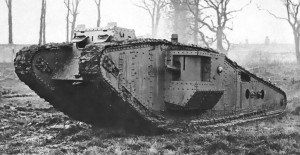Mark I Tank Facts
Created as a solution to trench warfare, the Mark I tank heralded a new era of armed conflict.
The world’s first ever combat tank, the Mark I has been entrenched in military history and the human consciousness for reasons both good and bad. With its unique rhomboid-shape design, progressive adoption of caterpillar tracks and ability to deliver massive firepower and armour in a mobile unit, it is celebrated as a great technical achievement that broke the domination of trench warfare.
However, it is also remembered as the invention that led many men to die in the most horrendous of manners, both enemy and ally alike, either mown down by its awesome firepower, or entombed in its hot, smoky innards, incinerated when its armour was breached. Technically, for the time its design and mechanics were revolutionary, but they came at the cost of an additional fatal separation between cause and effect – no longer were battles fought between men, they were fought between men and machines.
 The Mark I was powered by a Daimler six-cylinder, 13-litre capacity engine. Despite its large size, however, the engine was only capable of producing 105 brake horsepower and despite it being chosen for its reliability, because it was fitted in the same compartment of the tank as the rest of the crew, the fumes, noise and heat it produced made conditions incredibly challenging. The engine was initiated by four members of the crew winding a huge crank handle (similar to those on early fighter planes) and was cooled by water.
The Mark I was powered by a Daimler six-cylinder, 13-litre capacity engine. Despite its large size, however, the engine was only capable of producing 105 brake horsepower and despite it being chosen for its reliability, because it was fitted in the same compartment of the tank as the rest of the crew, the fumes, noise and heat it produced made conditions incredibly challenging. The engine was initiated by four members of the crew winding a huge crank handle (similar to those on early fighter planes) and was cooled by water.
As for weapons the primary, male-variant of the Mark 1 was mounted with two six-pounder naval guns, one in each sponson (rotatable turret-like structures on its sides), as well as three light machine guns. The lighter female variant of the Mark I was fitted with two heavy Vickers machine guns instead of the six-pounders. The Hotchkiss six-pounder naval guns had a range of 6,860 metres and were aimed with basic telescopic sights by their gunners. Each Mark I carried 334 shells.
In terms of defence, the thickness of the Mark I’s armour varied over its chassis. In crucial areas such as the front for example, it was 10mm thick, however elsewhere such as the rear, it was only a slight 6mm thick. This meant that while the tank could not be breached by small arms fire and shrapnel, any direct shell or mortar hit would likely breach its resistance threshold. As the First World War progressed, however, the creation of harder, armour-piercing bullets reduced the effectiveness of the armour.
Controlling the Mark I was an epic task, requiring four crew members working in unison. One driver operated the brakes, the other driver meanwhile operated the primary gearbox. Track control was then independently operated by the unit’s two gear men. Compounding this was the fact that inside the tank the noise of the engine was deafening, meaning that communication had to be conducted using both sign language and Morse code.
Automotive armour
 The concept of an armoured vehicle had been around long before the Mark I.
The concept of an armoured vehicle had been around long before the Mark I.
With the advent of the motor car in the later 19th Century, during the first decade of the 20th numerous self-propelled armoured fighting vehicles were designed and built in America and Europe. These vehicles tended to be modified motorcars, with armoured panels replacing standard chassis components and light machine guns mounted at the front and rears.
Although these vehicles were relatively effective on level terrain in cities and on roads -allowing decent firepower to be transported quickly over long distances – their use was rendered moot on the battlefield due to the muddy, inconsistent ground surface. Further, due to their light frame they were easily destroyed with grenades and shells.
Interesting facts about Mark I
Gender – There were two different types of the Mark I. There was the primary male variant, which was heavier and armed with dual cannons, as well as a lighter female version.
Risky – Communication between tanks and command posts relied on carrier pigeons -who had their own small exit hatch in the tank – as well as runners.
Salvage – The Mark I was susceptible to mortar fire as its fuel tanks were fitted high up in the cabin. These hits caused crews to be incinerated in the resultant blast.
Tail – In order for the Mark I to make slight turns it required the help of a steering tail, a dual-wheel trolley that when operated correctly would help turn the tank.
Noxious – The design of the Mark I placed the crew in the same compartment as the engine. Not surprisingly this led to an extremely hot and fume-heavy environment.
